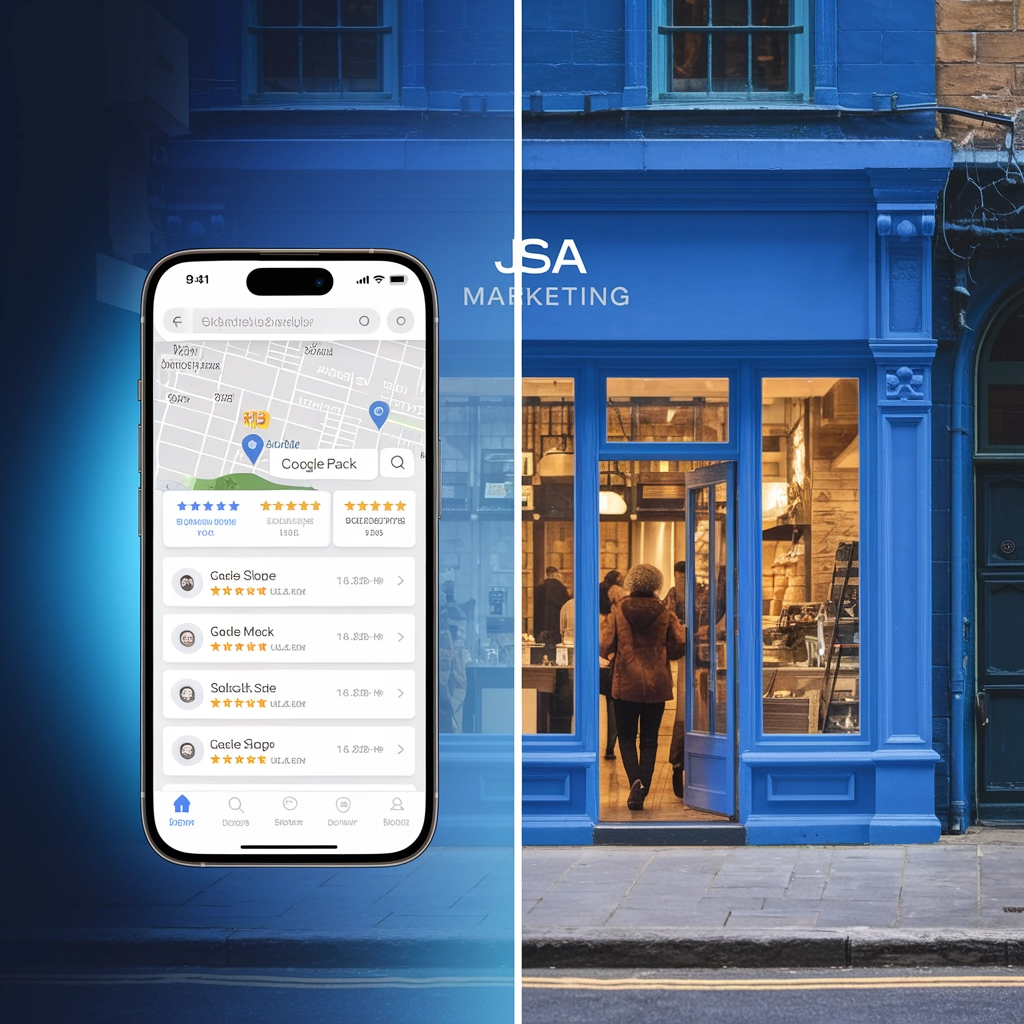
Home services portfolio resources blog Contact Facebook Instagram Linkedin X-twitter Quick SEO Tips for Local Businesses In today's digital landscape,...

In today's digital landscape, local businesses can't afford to ignore SEO. While it might seem like a complex strategy reserved for bigger companies, local SEO is actually an accessible, high-impact approach that puts small businesses on the map—literally. With 46% of all Google searches looking for local information and 88% of consumers who conduct a local search on their smartphone visiting a related store within 24 hours, the opportunity is massive.
But here's the challenge: many local business owners are overwhelmed by SEO jargon or believe they need a massive budget to compete. The truth? Several powerful local SEO tactics require minimal technical expertise and can be implemented quickly. Let's dive into actionable strategies that will boost your local visibility and bring more customers through your door.
Local SEO has evolved from a nice-to-have to an absolute necessity. With the rise of voice search ("near me" searches grew 900% over two years) and Google's increasingly localized results, your business needs to be properly positioned to capture this traffic.
Unlike traditional SEO that focuses on ranking anywhere in the world, local SEO targets potential customers in your specific geographic area. It's about showing up when someone in your city or neighborhood searches for the products or services you offer.

Your Google Business Profile (formerly Google My Business) isn't just another online listing—it's the foundation of your local search presence. Think of it as your business's digital storefront on Google.
Quick implementation tips:
A fully optimized Google Business Profile dramatically increases your chances of appearing in Google's "Local Pack"—those three highlighted business listings that appear in local searches. This prime real estate drives significant traffic and builds immediate credibility.
Local citations—mentions of your business name, address, and phone number (NAP) across the web—are powerful trust signals for search engines. When Google sees your business information consistently listed across trusted sites, it gains confidence in your legitimacy.
Focus on these high-impact citation sources:
The key is consistency—ensure your NAP information is identical across all platforms. Even minor differences (like using "Street" vs. "St.") can confuse search engines and dilute your local SEO power.
Your website should clearly signal to both visitors and search engines where you operate. Generic content won't cut it in local search.
Try these localization tactics:
"Content localization isn't just about sprinkling in city names," explains our SEO team at JSA Marketing Company LLC. "It's about demonstrating genuine local relevance and expertise that resonates with your community."
Online reviews might be the most underestimated aspect of local SEO. They directly influence your local search rankings, and they're often the deciding factor for potential customers.

Build your review strategy:
Remember that recency matters in reviews. A steady stream of fresh reviews signals to Google that your business is active and engaging with customers.
With 61% of mobile searches resulting in a phone call and 59% of searches having local intent, mobile optimization isn't optional—it's essential.
Mobile optimization checklist:
Understanding local search intent is equally important. Someone searching "coffee shops open now" has different intent than someone searching "best coffee beans Portland." Align your content with these various local intent patterns.
Backlinks remain a foundational ranking factor, but for local businesses, not all backlinks are created equal. Local relevance matters.
Local link building opportunities:
These locally-relevant links not only boost your search rankings but also increase your visibility within the community. For example, a local bakery sponsoring a charity run might earn a backlink from the event website while also connecting with hundreds of potential customers at the event itself.
You can't improve what you don't measure. Tracking specific local SEO metrics helps you understand what's working and where to focus your efforts.
Key metrics to monitor:
Free tools like Google Search Console, Google Analytics, and Google Business Profile Insights provide valuable data. For more comprehensive tracking, consider our SEO performance package designed specifically for local businesses.

Once you've implemented the fundamentals, consider these forward-looking strategies:
Leverage local voice search optimization: With nearly 60% of consumers using voice search to find local business information, optimizing for conversational queries is increasingly important. Focus on natural language patterns and question-based keywords.
Implement local schema markup: Technical SEO elements like LocalBusiness schema help search engines understand exactly what your business does and where it's located. This structured data can improve how your business appears in search results.
Create local content clusters: Develop comprehensive content around local topics relevant to your business. A dentist might create content clusters about local dental insurance options, oral health issues common in their climate, or community dental initiatives.
Even well-intentioned local SEO efforts can go astray. Watch out for these pitfalls:
Ready to transform your local search presence? Here's a simple 30-day implementation plan:
Days 1-7: Fully optimize your Google Business Profile and conduct a NAP consistency audit. Days 8-14: Implement on-site local SEO improvements and add localized content. Days 15-21: Create a review generation system and respond to all existing reviews. Days 22-30: Build your first five local backlinks and set up tracking metrics.
By following this methodical approach, you'll establish a solid local SEO foundation in just one month. For businesses wanting expert guidance, our team at JSA Marketing specializes in local SEO strategies tailored to your specific industry and community.
In a digital world that increasingly values "near me" over "best," local SEO gives small businesses a fighting chance against bigger competitors. With these actionable strategies, you can improve your visibility where it matters most—in your community, among the people most likely to become loyal customers.
The most successful local businesses understand that SEO isn't just about rankings—it's about connecting with real people looking for solutions you provide. By implementing these local SEO tips, you're not just improving search visibility; you're building bridges between your business and your community.
Ready to elevate your local SEO game? Start with the fundamentals outlined above, or reach out to our team for a personalized local SEO strategy that puts your business on the map.
In today’s digital age, Instagram has become a vital platform for businesses looking to enhance their online presence and engage with their audience. With over a billion active users, the platform offers immense opportunities for brand growth, customer engagement, and sales. However, standing out on Instagram requires more than just posting random pictures—it demands a well-thought-out strategy. Here are some essential tips to help you grow your business account on Instagram effectively.
Your Instagram profile serves as the first impression potential customers will have of your brand. To make it impactful:
Use a high-quality, recognizable profile picture—preferably your logo or brand mascot.
Write a compelling and concise bio that clearly defines your business, using strategic keywords that describe what you offer.
Include a clickable link to your website, landing page, or Linktree to direct traffic where you want it.
Select an appropriate Instagram handle that reflects your brand name and is easy to remember.
Choose a business category that aligns with your industry to make it easier for people to find you.
Enable action buttons like “Call,” “Email,” or “Shop” to allow users to connect with you quickly.
Content is king on Instagram. The more visually appealing and valuable your posts are, the more engagement you will receive. To achieve this:
Invest in high-quality images and videos that align with your brand’s identity.
Use tools like Canva, Adobe Spark, or Lightroom to enhance your content and maintain consistency.
Experiment with different content formats such as carousels, IGTV, and memes to keep your feed diverse and engaging.
Maintain a consistent aesthetic with a well-planned color scheme, theme, and font choices.
Use storytelling techniques to create emotional connections with your audience.
Post a mix of content types including educational, inspirational, promotional, and behind-the-scenes posts to keep your audience engaged.
Hashtags play a significant role in increasing the discoverability of your posts. To maximize their effectiveness:
Research and use a mix of trending, industry-specific, and branded hashtags.
Avoid overly generic hashtags (e.g., #love, #instagood) as they may not attract your target audience.
Use up to 30 hashtags per post but ensure they are relevant to your content.
Rotate hashtags frequently to avoid being flagged as spam by Instagram’s algorithm.
Create a branded hashtag to encourage user-generated content and brand awareness.
Building a strong community around your brand requires genuine interaction. Here’s how to boost engagement:
Respond to comments and direct messages promptly.
Like, comment, and share user-generated content that features your brand.
Run interactive stories using polls, Q&A, and quizzes to encourage participation.
Host giveaways and contests to reward followers and attract new ones.
Join relevant conversations by engaging with posts from potential customers and industry influencers.
Use Instagram’s “Close Friends” feature to create exclusive content for your most loyal followers.
Instagram’s Stories and Reels provide dynamic ways to connect with your audience. Utilize them effectively by:
Posting behind-the-scenes content, product launches, and customer testimonials.
Using stickers, GIFs, and interactive elements to make stories more engaging.
Leveraging Reels for short, entertaining videos that highlight your brand’s personality.
Saving important Stories as Highlights to keep valuable content accessible on your profile.
Collaborating with influencers or industry leaders in short-form video content.
Influencer marketing can significantly boost your reach and credibility. To make the most out of collaborations:
Partner with influencers whose audience aligns with your target market.
Choose influencers based on engagement rate rather than follower count.
Provide influencers with creative freedom while ensuring brand alignment.
Run co-branded campaigns or product giveaways to maximize exposure.
Use micro-influencers who have a niche but highly engaged following.
Paid advertising on Instagram can accelerate your growth and ensure that your content reaches the right audience. Here’s how to get started:
Choose the right ad format (Stories ads, carousel ads, video ads, etc.).
Target your audience strategically using Instagram’s detailed targeting options.
Test different creatives and messaging to see what resonates best.
Monitor ad performance and adjust your strategy based on key metrics.
Retarget website visitors or engaged users to increase conversions.
Timing is key when it comes to Instagram engagement. To optimize your posting schedule:
Use Instagram Insights to identify when your audience is most active.
Experiment with different posting times to determine what works best.
Schedule posts in advance using tools like Later or Buffer to maintain consistency.
Post consistently (at least 3-5 times per week) to keep your audience engaged.
Tracking your progress is essential for refining your strategy. Use Instagram Insights to:
Monitor engagement metrics such as likes, comments, shares, and saves.
Identify the best-performing posts and analyze why they succeeded.
Understand audience demographics to tailor content accordingly.
Optimize posting times based on when your followers are most active.
Set realistic goals and adjust your strategy accordingly.
Instagram is always evolving, so staying updated with the latest trends and features is crucial. Here’s how to stay ahead:
Follow Instagram’s official blog and social media accounts for announcements.
Join marketing and social media groups to keep up with industry insights.
Experiment with new features like Instagram Shopping, live videos, and AR filters.
Adapt your content strategy based on algorithm updates and user preferences.
By implementing these strategies, you can effectively grow your business account on Instagram, boost engagement, and increase brand visibility. The key is consistency, creativity, and interaction. Stay up to date with Instagram trends, experiment with new features, and always keep your audience’s interests in mind. With time and effort, your Instagram presence can become a powerful tool for business growth.

Home services portfolio resources blog Contact Facebook Instagram Linkedin X-twitter Quick SEO Tips for Local Businesses In today's digital landscape,...

Home services portfolio resources blog Contact Facebook Instagram Linkedin X-twitter How Storytelling Enhances Brand Loyalty In a world where consumers...

Home services portfolio resources blog Contact Facebook Instagram Linkedin X-twitter Essential Features Every Business Website Should Have In today's digital...
Home services portfolio resources blog Contact Facebook Instagram Linkedin X-twitter AI-Generated Content: The Future of Blogging? The Rise of AI...

Home services portfolio resources blog Contact Facebook Instagram Linkedin X-twitter The Psychology of Colors in Branding Have you ever wondered...

Home services portfolio resources blog Contact Facebook Instagram Linkedin X-twitter 10 Days to a Standout Brand: How Rapid Marketing Transforms...
By subscribing you agree to JSA Marketing Company’s Privacy Policy and to receiving regular communications from JSA Marketing Company.
By subscribing you agree to JSA Marketing Company’s Privacy Policy and to receiving regular communications from JSA Marketing Company.
Privacy Policy || Copyright © JSA Marketing Company LLC 2025. All Right Reserved